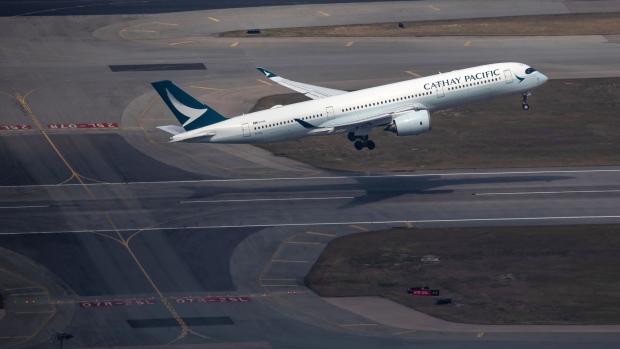Oct 30, 2022
Cathay Pacific to Restore Some Flights Using Russian Airspace
, Bloomberg News

(Bloomberg) -- Cathay Pacific Airways Ltd. will restart using Russian airspace several months after Moscow’s war in Ukraine upended the aviation industry and global flight paths, becoming among the earliest of major airlines to do so.
Hong Kong’s main airline will fly from New York to the Asian financial hub using the so-called Polar Route from Nov. 1, the company said in an emailed response to a query by Bloomberg News. It cited strong headwinds and payload issues affecting its flights from the east coast of North America, and said its aircraft will overfly the far eastern part of Russia.
Cathay said in March that it rerouted flights away from Russian airspace. Resuming its use will slash some flight times and save money on fuel costs, but the airline has to pay an overflight fee per trip to Russian authorities for the right to fly over Siberia.
“There are other major airlines overflying Russian airspace and there are no sanctions which prevent Cathay Pacific overflying Russia,” Cathay said in the statement to Bloomberg. “The Polar Route provides a safe, direct and the fastest flight experience to our customers traveling from the East Coast of North America to Hong Kong.”
Read more: Asia Flights Return, But Russia Airspace Bans Make Them Costlier
After flight bans were imposed on Russia in response to its war on Ukraine, Moscow retaliated by closing its airspace to countries and airlines it considered enemies. While the rule affects western carriers across Europe and North America, subsequently, most Asian airlines including Korean Air and All Nippon Airways stopped using Russian airspace, citing safety concerns.
Russian airspace spans 5,600 miles (9,012 kilometers) adjacent from the eastern fringes Asia and the US state of Alaska to the tip of northern Europe in Finland. Its airspace is a critical link and provides a short-cut on flight times via polar routes.
The US has led western allies to apply economic pressure on Russia as punishment for waging war on Ukraine, from oil to luxury goods, and the financial sector. Airlines from India, Turkey, the Middle East and Chinese are currently the ones predominantly using Russian airspace unimpeded while western rivals navigate extended flight times on the same routes.
Read more: Siberian ‘Detour’ Forces Airlines to Retrace Cold War Era Routes
In an operational note to pilots dated Oct. 28, Cathay outlined the policy change for flights from North America to facilitate a “safe and more efficient operation” for its crew and customers, according to people familiar with the notice.
On Oct. 12, Cathay’s Flight 841 flew 10,365 miles from New York to Hong Kong, the longest passenger flight by distance in the company’s history. It flew to the Asian financial hub over the Atlantic Ocean and Europe in 17 hours and 8 minutes. A FlightRadar24 search of the same flight before the Ukraine war, which used a polar route, took around 15 hours.
The Polar Route “allows the airline to maximize the number of passengers and checked baggage carried onboard,” Cathay said. “It also eliminates the need for a technical stop in another city for a change of aircrew as necessitated by mandated flight time limitations.”
The Hong Kong carrier’s advisory notice to pilots also said flights will be planned with “no dependencies on any airports within Russia and none should be considered or allowed.”
Read more: World’s Longest Passenger Flight Planned to Avoid Russian Skies
Few airlines have provided public updates if they too plan to reuse Russian airspace.
Korean Air said it was not currently using the Polar Route. Singapore Airlines, Japan Airlines, ANA, China Airlines and EVA Air did not respond to requests for comment.
©2022 Bloomberg L.P.






